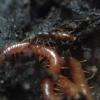https://www.theatlan...rground/622066/
Great read about the world our ants came from. I bet all these species are a lot more noise-attuned than we realize.
The first time that Marcus Maeder stuck a noise sensor into the ground, it was on a whim. A sound artist and an acoustic ecologist, he was sitting in a mountain meadow and pushed a special microphone he’d built into the soil. “I was just curious,” says Maeder, who is working on a dissertation on the sounds of biodiversity at the Swiss Federal Institute of Technology, in Zürich.
He certainly wasn’t prepared for the clamor of sounds that started to flood his headset. “They were very strange. There was thrumming and chirring and scraping. You need a whole new vocabulary to describe it.” Maeder was eavesdropping, he realized, on creatures that live in the soil.
And every soil organism produces its own soundtrack. Root-munching larvae emit short clicks as they break the fibers of their meal. Worms rustle as they crawl through tunnels; so do plant roots as they push past grains of soils, as researchers reported in 2018. But the roots move slower than the worms do, and at a steadier pace.
Subterranean vibrations can also be key for what appear to be intended signals. Mole rats, living in underground burrows, are thought to communicate with other mole rats in the vicinity by banging their heads or feet against the walls of their tunnels. Leafcutter ants have been observed to create noises when they get buried during nest cave-ins. Other worker ants rush to the spot and start to dig to rescue their nestmate.
Some of these underground sounds are audible to the human ear, but many are too high or too low in frequency (as well as in volume). To capture these, researchers use tools such as piezoelectric sensors, which work like the contact microphones you might clip onto a guitar. Attached to a nail, sometimes up to 30 centimeters long, that has been pushed into the ground, these sensors detect vibrations that researchers then convert into electronic signals and amplify until humans can hear them.
Edited by m99, February 12 2022 - 11:45 AM.



















